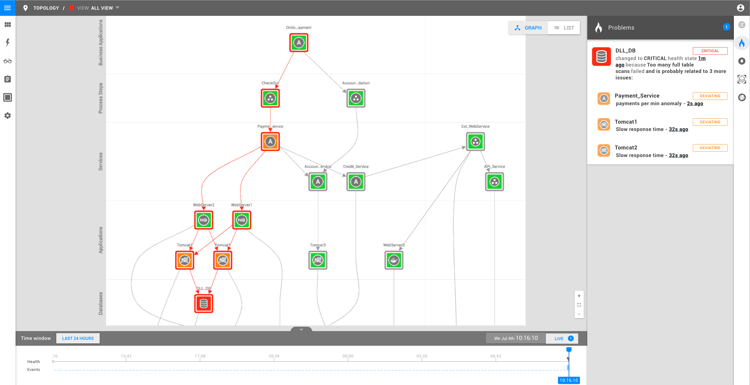Moving your complex applications and infrastructure to the cloud can be a massive undertaking and requires careful preparation. During each stage of the cloud migration process, you will face different monitoring challenges. But, don’t worry, we have you covered. Here’s an overview of the top 3 cloud migration monitoring challenges you will face and how you can tackle them with AIOps.
Before Migration- Knowing All Application and Infrastructure Dependencies
Applications and underlying infrastructure components are critical to support your business processes, but they run across containers, virtual and physical servers and are continuously interacting with each other. Before you consider a cloud migration, you need to gain a precise understanding of your existing IT landscape’s architecture. That means you need to visualize each and every application and infrastructure component, its dependencies and performance requirements.
If you perform a cloud migration without a real-time and up-to-date understanding of how your applications and infrastructure make up different business services is a big risk and can lead to downtime and unhappy customers.
Today’s AIOps solutions are built to discover all business and IT components including their dependencies from business process level all the way down to the hardware level. No matter the cloud, application or the infrastructure, you are able to view and understand your entire dynamic IT landscape’s topology with zero blind spots and connect to every single component. With AIOps you don’t have to rely on outdated and static representations of your IT landscape.
This visibility makes it also easier for you to identify which parts (and whether other parts should be migrated at the same time as well) of your landscape you should migrate first.
 StackState's AIOps solution creates a real-time dependency map of all your applications and related infrastructure
StackState's AIOps solution creates a real-time dependency map of all your applications and related infrastructure
During Migration - Troubleshooting Issues
Cloud introduces a new level of complexity where even the best IT Operators can’t root-cause issues across dynamic and hybrid environments.
A soon as you migrate your first workload to the cloud, your traditional monitoring approach is effectively broken. The cloud provider supplies monitoring tools that let you know about their infrastructure, but does not see what happens in your on-premise environments and vice versa. Problems often occur at the intersection between these two sides and knowing where a fix must be applied is crucial to guarantee SLAs and stable infrastructure services.
AIOps platform’s data- source-agnostic approach lends itself to seamlessly integrate with cloud computing services and thus provide valuable visibility during your cloud migration process. This enables you to auto-detect issues by a single person and immediately know what you can do about it. Even if they cross cloud and on-premise boundaries.
.png?width=750&name=image%20(1).png) Root-cause issues instantly and know what you can do about it. Even if they cross cloud and on-premise boundaries.
Root-cause issues instantly and know what you can do about it. Even if they cross cloud and on-premise boundaries.
After Migration – Monitoring Your Environment
After the switch to the cloud, it’s critical that you keep monitoring your new environment to guarantee great customer experiences. The monitoring tools that you’re currently using must be capable of everything you would expect from a traditional monitoring tool, but also be capable of providing visibility into your applications and infrastructure that now spans multiple cloud and on-premise environments. Having full stack visibility is therefore key to stay in control.
In highly dynamic cloud environments, nothing is static anymore. Parts of your landscape automatically move, scale down or up dependent on the load at any given moment. That means that your monitoring solution should support auto-discovery and identification of new services that continuously spin-up and down.
At the end of the day, you just want to succeed with your cloud transformation and not spend too much time monitoring it. To do so, you need a monitoring vendor that ensures full stack visibility across your dynamic and legacy environments and helps with automated troubleshooting when issues occur.
Do you want to learn more about AIOps and how it accelerates your cloud transformation? Download our free Guide to AIOps to get a better understanding of the newest trend in IT.




